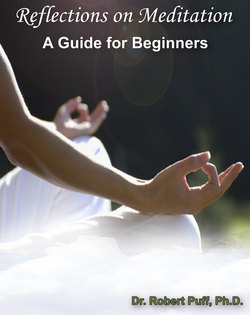Reflections on Meditation: A Guide for Beginners

Реклама. ООО «ЛитРес», ИНН: 7719571260.
Оглавление
Dr. Robert Ph.D. Puff PhD. Reflections on Meditation: A Guide for Beginners
1 The Value of Meditation
2 How to Meditate
3 Breath Meditation
4 Walking Meditation
5 The Benefits of Meditation
6 My Personal Journey
7 Meditation and Synchronicity
8 Preparing to Meditate
9 Overcoming Obstacles
10 The Stabilizing Power of Meditation
11 Eating Mindfully
12 Stress Reduction
13 Eliminating Fears
14 Living a Meditative Life
15 Starting the Day Right
16 The Importance of Being Earnest
17 Enlightenment
18 How to Meditate Anywhere
19 Making a Place to Meditate
20 Why We Don’t Meditate
21 Labyrinths
22 Living in the Moment
23 Attachments
24 Awareness
25 Financial and Health Benefits
26 The Value of Retreats
27 Final Suggestions
Отрывок из книги
Meditation has been around for almost as long as human history. At its core, meditation is a technique that helps us quiet our minds. I’m sure you’ve noticed, throughout the day, all the repetitive thoughts that tend to course through your mind. I call it mind chatter. It’s sort of like a commentary on life. Sometimes we ignore it, while other times we pay attention to these commentaries. We stop, reflect, and focus on them. We think about the past or we think about what might be in the future. All this thinking, all this noise in our minds, keeps us from being silent and present with what is in the moment. We miss so much of what’s going on in the world because we constantly have this mind chatter, spoiling our appreciation for what’s happening in the now.
What meditation can do is bring us to the silence, to the present. Meditation is a technique for quieting the mind, shutting down the mind chatter so that we can be still and one-hundred-percent present with the now. The hope is that as you learn to meditate you can transfer the gift of meditation, of being totally present to what is, to your daily life. If you can implement this, you will find you’ll have a much more blissful, peaceful, and happier life.
.....
Begin the session with a few deep breaths. Then begin thinking the phrase, and just let yourself breathe normally. Don’t try to control the rate of your breathing, whether it’s deep or shallow. Let it be whatever the body wants it to be. The deeper you go in consciousness, the shallower the breath will typically become. Indian master yogis in advanced states of meditation have been found to stop breathing completely for extended periods of time, so don’t be concerned if it seems your breathing has almost stopped for a little while. This happens because the body is in such a deep state of rest and stillness that breathing, for a time, is hardly needed. Be assured: the body is perfectly capable of resuming deeper breathing whenever it so desires and will take breaths as it needs to. It’s all a very natural process, and you will feel rested and energized when you come out of it.
Now a word about coming out. It’s a good idea not to jump up quickly after meditation. This would be as jarring as jumping quickly out of bed after a very deep sleep. Take about three minutes to come back to a normal waking-state of consciousness. During this time, you can move around a little to let your body know it’s time to prepare for activity. Or, if you’re sleepy, you can just lie down and fall asleep.
.....